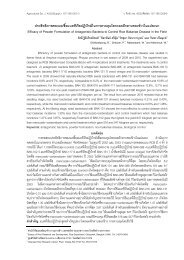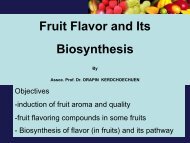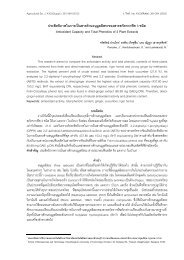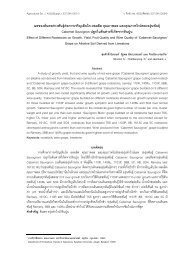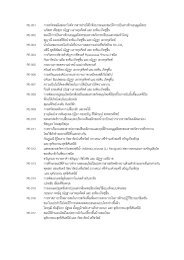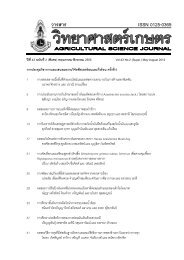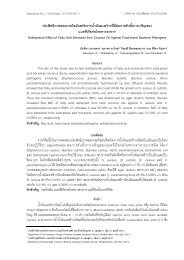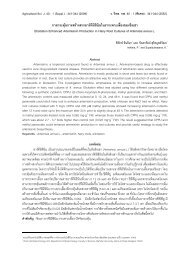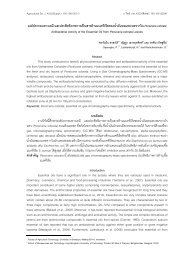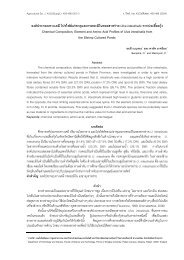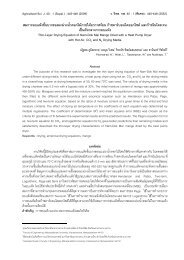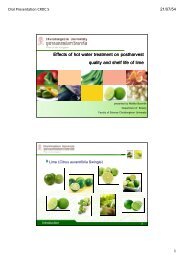à¸à¸§à¸²à¸¡ à¹à¸à¸µà¹à¸¢à¸§à¸à¹à¸à¸à¸à¸à¸ antioxidant enzymes à¹à¸¥à¸° lipid ... - CRDC
à¸à¸§à¸²à¸¡ à¹à¸à¸µà¹à¸¢à¸§à¸à¹à¸à¸à¸à¸à¸ antioxidant enzymes à¹à¸¥à¸° lipid ... - CRDC
à¸à¸§à¸²à¸¡ à¹à¸à¸µà¹à¸¢à¸§à¸à¹à¸à¸à¸à¸à¸ antioxidant enzymes à¹à¸¥à¸° lipid ... - CRDC
Create successful ePaper yourself
Turn your PDF publications into a flip-book with our unique Google optimized e-Paper software.
554 ปี ที่ 41 ฉบับที่ 3/1 (พิเศษ) กันยายน-ธันวาคม 2553 ว. วิทยาศาสตร์เกษตร<br />
Introduction<br />
Priming has been widely used to improve seed germination and vigour in many crop species. The advantages<br />
of priming, improved seed vigour, are reported to involve with the repair and build up of nucleic acids, the<br />
increased synthesis of proteins as well as the repair of membranes (McDonald, 1999). Priming also enhances the<br />
activities of scavenging <strong>enzymes</strong> and reduces <strong>lipid</strong> peroxidation, indicating by MDA content, result to the increase<br />
in seed germination and vigour in purple coneflower (Chiu et al., 2006) and bitter gourd seeds (Wang et al.,<br />
2003). However, improper priming processes, due to the unfavorable imbibitions and re-drying steps, generate<br />
reactive oxygen species (ROS) such as superoxide radical (O 2 - ), hydrogen peroxide (H 2 O 2 ) and hydroxyl radical<br />
(Leprince et al., 1994). ROS can initiate injurious degradation causing <strong>lipid</strong> peroxidation, membrane deterioration,<br />
protein and nucleic acids degradation leading to reduce seed vigour and cell death (McDonald, 1999).The poorer<br />
longevity of primed sh-2 sweet corn seeds than unprimed seeds was found (Chang and Sung, 1998). The effect of<br />
priming on seed vigour and biochemical mechanisms is depended on seed species and priming methods<br />
(McDonald, 1999). The aim of this research was to study the involvement of <strong>antioxidant</strong> <strong>enzymes</strong> and <strong>lipid</strong><br />
peroxidation on seed vigour of maize seeds cv. Suwan 5 through the variations of hydropriming times.<br />
Material and Methods<br />
Maize seeds (Zea mays L.) ‘Suwan 5’, harvested in December, 2008, was purchased from Nation Corn and<br />
Sorghum Research Center (NCSRC). The seeds were hydroprimed by placing them on metal wire sieve container<br />
laying on distilled water surface for 6-18 h at 25C. Thereafter, the imbibed seeds were immediately dried at 40C<br />
for 24 h to reduce the moisture content down to initial moisture content. The unprimed seeds were used as a<br />
control sample. Moisture content (%), germination (%), vigour test (accelerated ageing test at 42C and 100%RH<br />
for 96 h) of primed and unprimed seeds was investigated followed by ISTA rule (2007). The <strong>lipid</strong> peroxidation was<br />
explained in term of malondialdehyde (MDA) content in the seeds (Tamagnone et al., 1998). Superoxide<br />
dismutase (SOD) (Beauchamp and Fridovish, 1971) and ascobate peroxidase (APX) (Nakano and Asada, 1987)<br />
were analyzed. The experiment was arranged as a completely randomized design (CRD) with four replications.<br />
Data were subjected to analysis of variance (ANOVA) and significant differences among means were determined<br />
by Duncan’s New Multiple Range Test at P



